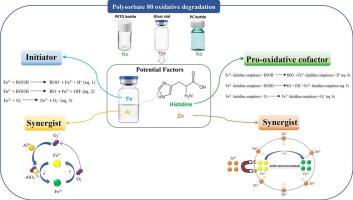Mechanistic insights into PS80 oxidative degradation in glass vials: Roles of critical factors (iron, histidine, aluminum, zinc) and their synergistic interactions
IF 4.3
2区 医学
Q1 PHARMACOLOGY & PHARMACY
European Journal of Pharmaceutics and Biopharmaceutics
Pub Date : 2025-09-02
DOI:10.1016/j.ejpb.2025.114853
引用次数: 0
Abstract
Polysorbate 80 (PS80), a vital stabilizer in biotherapeutic formulations, faces persistent oxidative degradation challenges that threaten drug product stability during storage. While PS80 instability has been studied for decades, the oxidation mechanisms in specific formulation-packaging systems remain poorly understood. This work resolves this knowledge gap by demonstrating that PS80 oxidative degradation occurs exclusively in histidine-buffered formulations stored in glass vials. This phenomenon was found to be driven by four factors: iron (leaching from vials promoted by histidine), histidine, zinc (histidine-introduced) and aluminum (glass-derived). These four interdependent factors exhibited a unique functional synergy: 1) iron as the radical chain initiator; 2) histidine as a pro-oxidative cofactor lowering iron’s catalytic threshold via formation of an iron-histidine complex; 3) zinc and aluminum accelerate Fe2+/Fe3+ redox cycling through distinct potential-specific mechanisms, enhancing the overall catalytic efficiency. This study for the first time provides the systematic evidence of the histidine-glass system as an essential prerequisite for PS80 oxidation and reveals novel mechanistic insights on the interplay between formulation composition and packaging-derived contaminants. The findings establish a predictive framework to mitigate PS80 oxidative degradation, ultimately enhancing the stability and safety of protein therapeutics.

PS80在玻璃小瓶中氧化降解的机理:关键因素(铁、组氨酸、铝、锌)的作用及其协同作用
聚山梨酯80 (PS80)是生物治疗制剂中重要的稳定剂,在储存过程中面临持续氧化降解的挑战,威胁药品的稳定性。虽然PS80的不稳定性已经研究了几十年,但在特定配方包装系统中的氧化机制仍然知之甚少。这项工作通过证明PS80氧化降解只发生在储存在玻璃小瓶中的组氨酸缓冲制剂中,解决了这一知识差距。这种现象被发现是由四个因素驱动的:铁(由组氨酸促进的小瓶浸出)、组氨酸、锌(组氨酸引入)和铝(玻璃衍生)。这四个相互依赖的因素表现出独特的功能协同作用:1)铁作为自由基链引发剂;2)组氨酸作为一种促氧化辅助因子,通过铁-组氨酸复合物的形成降低铁的催化阈值;3)锌和铝通过不同的电位特异性机制加速Fe2+/Fe3+氧化还原循环,提高了整体催化效率。这项研究首次提供了组氨酸-玻璃系统作为PS80氧化的必要先决条件的系统证据,并揭示了配方组成和包装衍生污染物之间相互作用的新机制见解。这些发现为减轻PS80氧化降解建立了一个预测框架,最终提高了蛋白质治疗的稳定性和安全性。
本文章由计算机程序翻译,如有差异,请以英文原文为准。
求助全文
约1分钟内获得全文
求助全文
来源期刊
CiteScore
8.80
自引率
4.10%
发文量
211
审稿时长
36 days
期刊介绍:
The European Journal of Pharmaceutics and Biopharmaceutics provides a medium for the publication of novel, innovative and hypothesis-driven research from the areas of Pharmaceutics and Biopharmaceutics.
Topics covered include for example:
Design and development of drug delivery systems for pharmaceuticals and biopharmaceuticals (small molecules, proteins, nucleic acids)
Aspects of manufacturing process design
Biomedical aspects of drug product design
Strategies and formulations for controlled drug transport across biological barriers
Physicochemical aspects of drug product development
Novel excipients for drug product design
Drug delivery and controlled release systems for systemic and local applications
Nanomaterials for therapeutic and diagnostic purposes
Advanced therapy medicinal products
Medical devices supporting a distinct pharmacological effect.

 求助内容:
求助内容: 应助结果提醒方式:
应助结果提醒方式:


